Strategic Analysis with Reference to BlackBerry/Apple
VerifiedAdded on 2023/06/12
|15
|3473
|479
AI Summary
This paper provides an overview on different strategies that a firm can adopt to gain its competitive edge over the rivals and underscore its financial sustainability as well as maintaining efficiency in reference to Blackberry situation. The paper includes SWOT Analysis, PESTEL Analysis, TR Technology Cycle, Porter’s Five Forces, and the 3 Phases of Innovative Model.
Contribute Materials
Your contribution can guide someone’s learning journey. Share your
documents today.

Strategic Analysis 1
STRATEGIC ANALYSIS WITH REFERENCE TO BLACKBERRY/APPLE
Name
Institution
Course
Tutor
City/State
Date
STRATEGIC ANALYSIS WITH REFERENCE TO BLACKBERRY/APPLE
Name
Institution
Course
Tutor
City/State
Date
Secure Best Marks with AI Grader
Need help grading? Try our AI Grader for instant feedback on your assignments.

Strategic Analysis 2
Table of Contents
Introduction................................................................................................................................2
SWOT Analysis.........................................................................................................................3
PESTEL Analysis.......................................................................................................................6
TR Technology Cycle................................................................................................................7
Porter’s Five Forces...................................................................................................................8
Three Phases of Innovative Model...........................................................................................10
Conclusion................................................................................................................................10
List of References....................................................................................................................12
Table of Contents
Introduction................................................................................................................................2
SWOT Analysis.........................................................................................................................3
PESTEL Analysis.......................................................................................................................6
TR Technology Cycle................................................................................................................7
Porter’s Five Forces...................................................................................................................8
Three Phases of Innovative Model...........................................................................................10
Conclusion................................................................................................................................10
List of References....................................................................................................................12
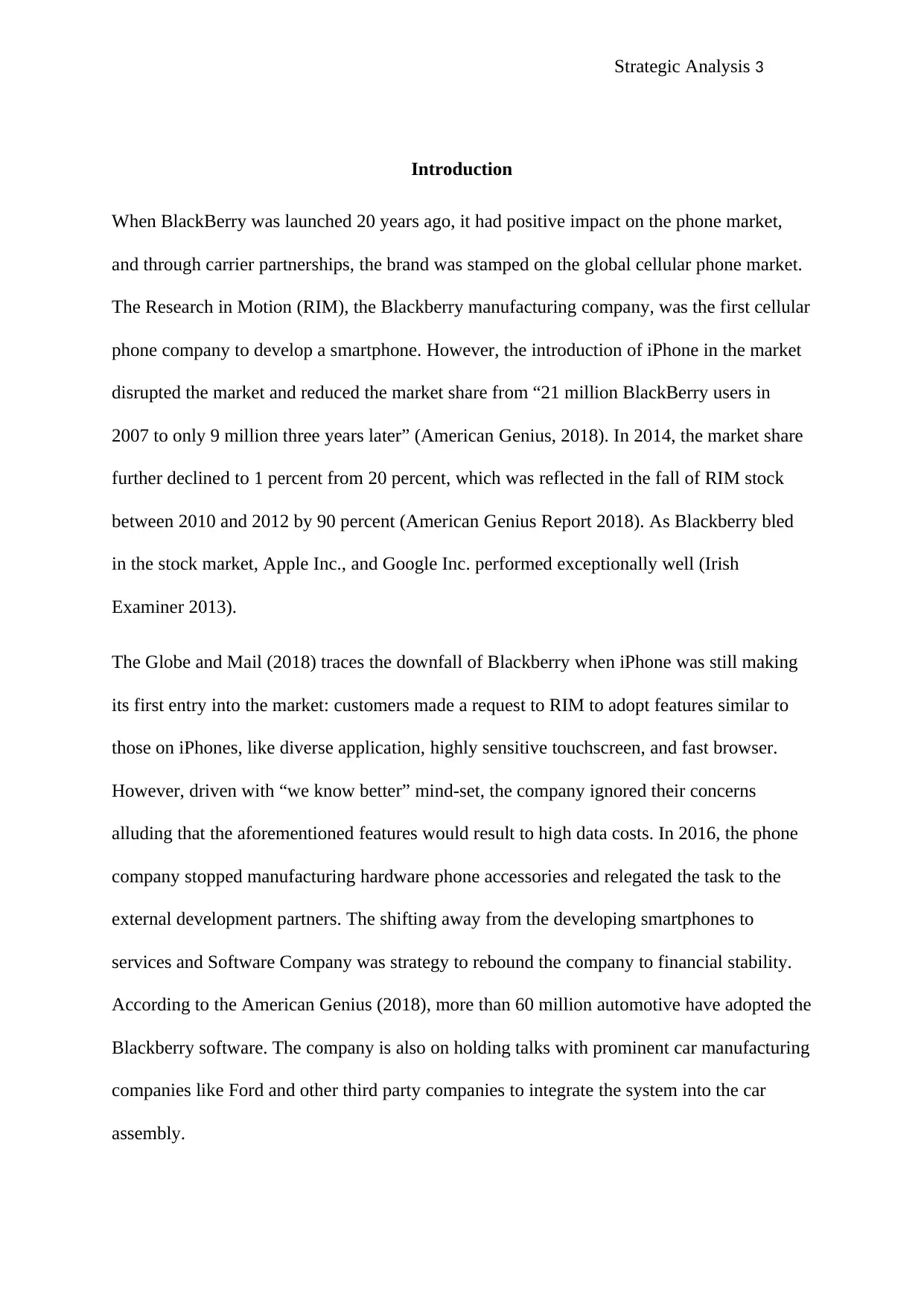
Strategic Analysis 3
Introduction
When BlackBerry was launched 20 years ago, it had positive impact on the phone market,
and through carrier partnerships, the brand was stamped on the global cellular phone market.
The Research in Motion (RIM), the Blackberry manufacturing company, was the first cellular
phone company to develop a smartphone. However, the introduction of iPhone in the market
disrupted the market and reduced the market share from “21 million BlackBerry users in
2007 to only 9 million three years later” (American Genius, 2018). In 2014, the market share
further declined to 1 percent from 20 percent, which was reflected in the fall of RIM stock
between 2010 and 2012 by 90 percent (American Genius Report 2018). As Blackberry bled
in the stock market, Apple Inc., and Google Inc. performed exceptionally well (Irish
Examiner 2013).
The Globe and Mail (2018) traces the downfall of Blackberry when iPhone was still making
its first entry into the market: customers made a request to RIM to adopt features similar to
those on iPhones, like diverse application, highly sensitive touchscreen, and fast browser.
However, driven with “we know better” mind-set, the company ignored their concerns
alluding that the aforementioned features would result to high data costs. In 2016, the phone
company stopped manufacturing hardware phone accessories and relegated the task to the
external development partners. The shifting away from the developing smartphones to
services and Software Company was strategy to rebound the company to financial stability.
According to the American Genius (2018), more than 60 million automotive have adopted the
Blackberry software. The company is also on holding talks with prominent car manufacturing
companies like Ford and other third party companies to integrate the system into the car
assembly.
Introduction
When BlackBerry was launched 20 years ago, it had positive impact on the phone market,
and through carrier partnerships, the brand was stamped on the global cellular phone market.
The Research in Motion (RIM), the Blackberry manufacturing company, was the first cellular
phone company to develop a smartphone. However, the introduction of iPhone in the market
disrupted the market and reduced the market share from “21 million BlackBerry users in
2007 to only 9 million three years later” (American Genius, 2018). In 2014, the market share
further declined to 1 percent from 20 percent, which was reflected in the fall of RIM stock
between 2010 and 2012 by 90 percent (American Genius Report 2018). As Blackberry bled
in the stock market, Apple Inc., and Google Inc. performed exceptionally well (Irish
Examiner 2013).
The Globe and Mail (2018) traces the downfall of Blackberry when iPhone was still making
its first entry into the market: customers made a request to RIM to adopt features similar to
those on iPhones, like diverse application, highly sensitive touchscreen, and fast browser.
However, driven with “we know better” mind-set, the company ignored their concerns
alluding that the aforementioned features would result to high data costs. In 2016, the phone
company stopped manufacturing hardware phone accessories and relegated the task to the
external development partners. The shifting away from the developing smartphones to
services and Software Company was strategy to rebound the company to financial stability.
According to the American Genius (2018), more than 60 million automotive have adopted the
Blackberry software. The company is also on holding talks with prominent car manufacturing
companies like Ford and other third party companies to integrate the system into the car
assembly.
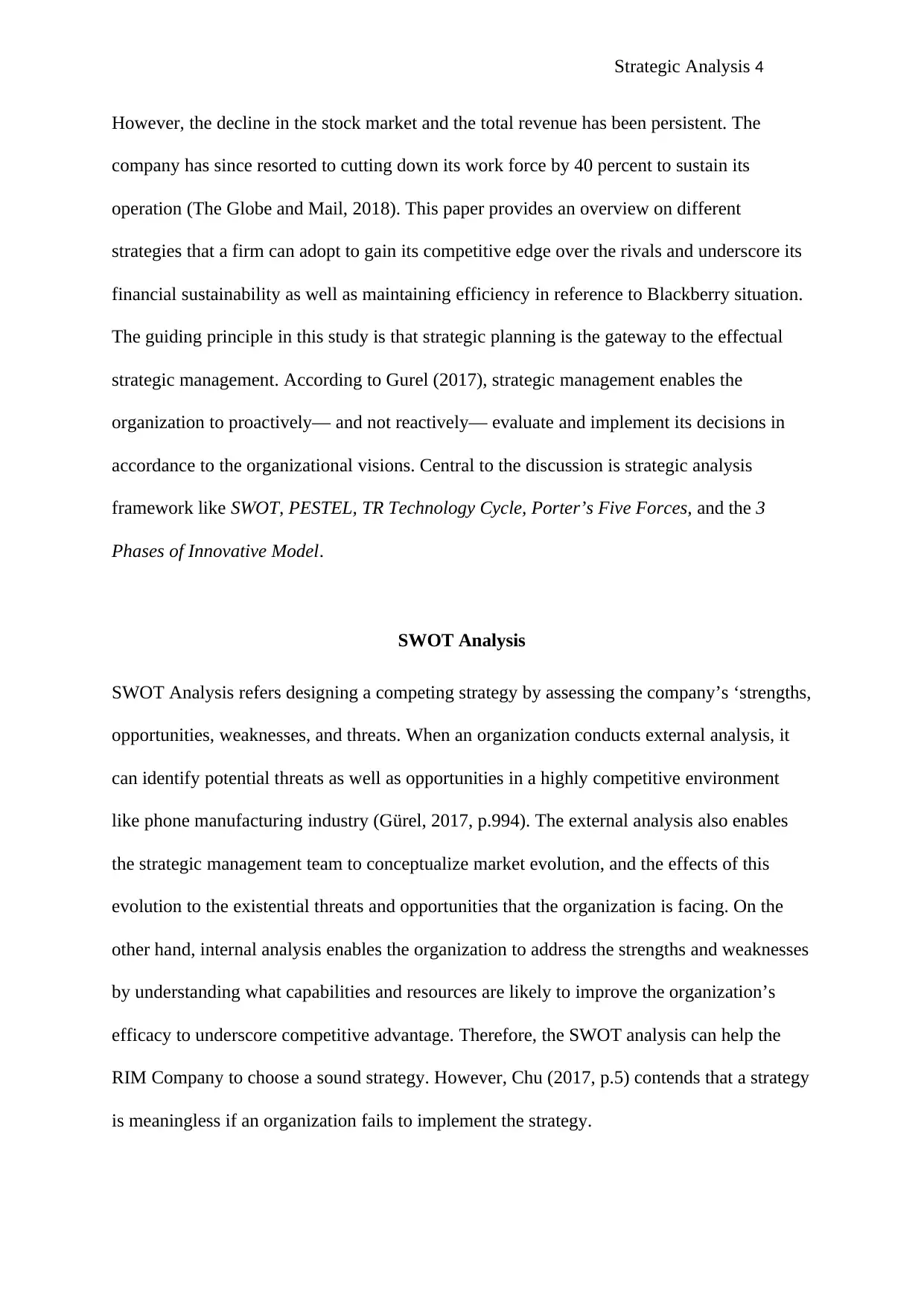
Strategic Analysis 4
However, the decline in the stock market and the total revenue has been persistent. The
company has since resorted to cutting down its work force by 40 percent to sustain its
operation (The Globe and Mail, 2018). This paper provides an overview on different
strategies that a firm can adopt to gain its competitive edge over the rivals and underscore its
financial sustainability as well as maintaining efficiency in reference to Blackberry situation.
The guiding principle in this study is that strategic planning is the gateway to the effectual
strategic management. According to Gurel (2017), strategic management enables the
organization to proactively— and not reactively— evaluate and implement its decisions in
accordance to the organizational visions. Central to the discussion is strategic analysis
framework like SWOT, PESTEL, TR Technology Cycle, Porter’s Five Forces, and the 3
Phases of Innovative Model.
SWOT Analysis
SWOT Analysis refers designing a competing strategy by assessing the company’s ‘strengths,
opportunities, weaknesses, and threats. When an organization conducts external analysis, it
can identify potential threats as well as opportunities in a highly competitive environment
like phone manufacturing industry (Gürel, 2017, p.994). The external analysis also enables
the strategic management team to conceptualize market evolution, and the effects of this
evolution to the existential threats and opportunities that the organization is facing. On the
other hand, internal analysis enables the organization to address the strengths and weaknesses
by understanding what capabilities and resources are likely to improve the organization’s
efficacy to underscore competitive advantage. Therefore, the SWOT analysis can help the
RIM Company to choose a sound strategy. However, Chu (2017, p.5) contends that a strategy
is meaningless if an organization fails to implement the strategy.
However, the decline in the stock market and the total revenue has been persistent. The
company has since resorted to cutting down its work force by 40 percent to sustain its
operation (The Globe and Mail, 2018). This paper provides an overview on different
strategies that a firm can adopt to gain its competitive edge over the rivals and underscore its
financial sustainability as well as maintaining efficiency in reference to Blackberry situation.
The guiding principle in this study is that strategic planning is the gateway to the effectual
strategic management. According to Gurel (2017), strategic management enables the
organization to proactively— and not reactively— evaluate and implement its decisions in
accordance to the organizational visions. Central to the discussion is strategic analysis
framework like SWOT, PESTEL, TR Technology Cycle, Porter’s Five Forces, and the 3
Phases of Innovative Model.
SWOT Analysis
SWOT Analysis refers designing a competing strategy by assessing the company’s ‘strengths,
opportunities, weaknesses, and threats. When an organization conducts external analysis, it
can identify potential threats as well as opportunities in a highly competitive environment
like phone manufacturing industry (Gürel, 2017, p.994). The external analysis also enables
the strategic management team to conceptualize market evolution, and the effects of this
evolution to the existential threats and opportunities that the organization is facing. On the
other hand, internal analysis enables the organization to address the strengths and weaknesses
by understanding what capabilities and resources are likely to improve the organization’s
efficacy to underscore competitive advantage. Therefore, the SWOT analysis can help the
RIM Company to choose a sound strategy. However, Chu (2017, p.5) contends that a strategy
is meaningless if an organization fails to implement the strategy.
Secure Best Marks with AI Grader
Need help grading? Try our AI Grader for instant feedback on your assignments.
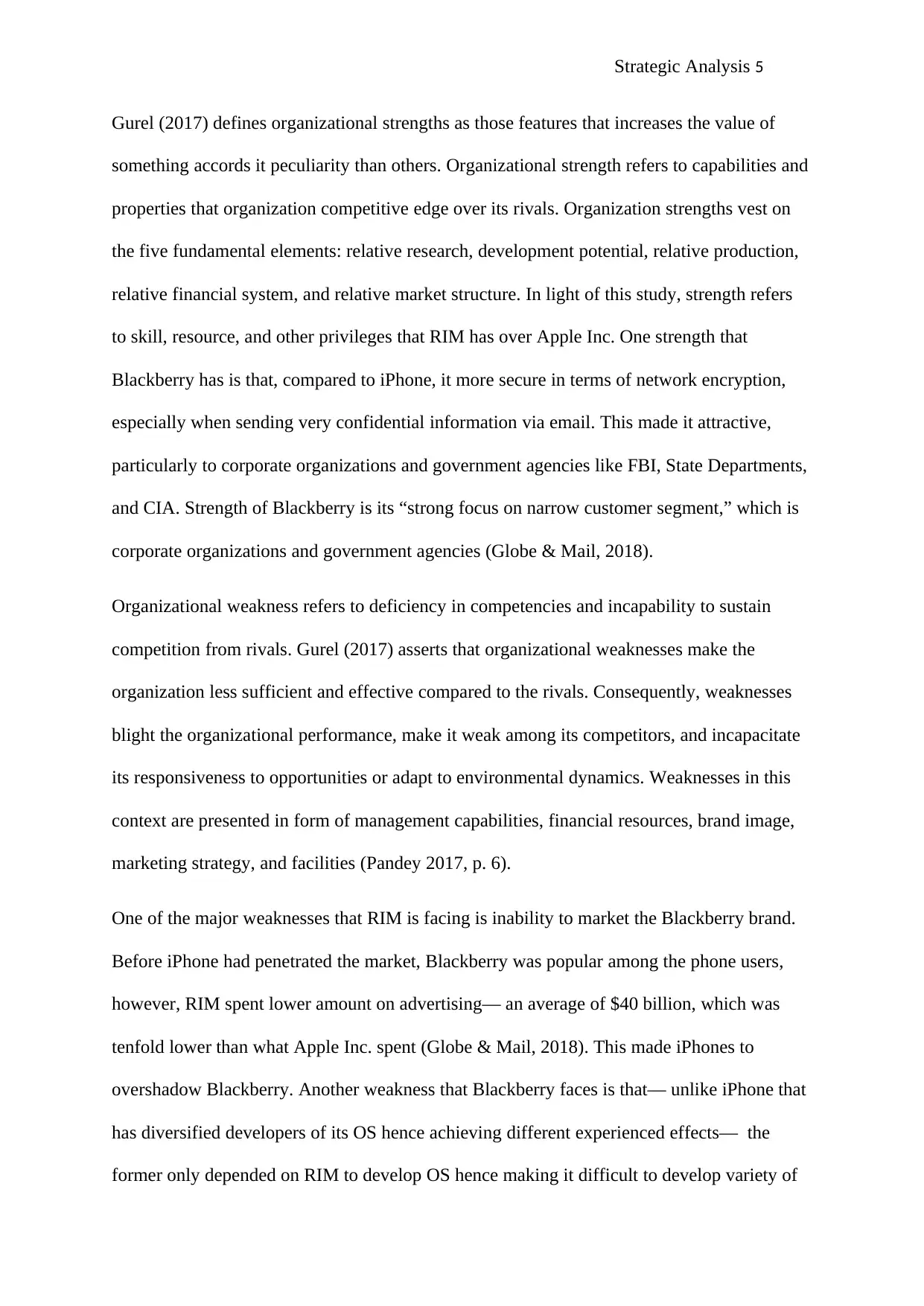
Strategic Analysis 5
Gurel (2017) defines organizational strengths as those features that increases the value of
something accords it peculiarity than others. Organizational strength refers to capabilities and
properties that organization competitive edge over its rivals. Organization strengths vest on
the five fundamental elements: relative research, development potential, relative production,
relative financial system, and relative market structure. In light of this study, strength refers
to skill, resource, and other privileges that RIM has over Apple Inc. One strength that
Blackberry has is that, compared to iPhone, it more secure in terms of network encryption,
especially when sending very confidential information via email. This made it attractive,
particularly to corporate organizations and government agencies like FBI, State Departments,
and CIA. Strength of Blackberry is its “strong focus on narrow customer segment,” which is
corporate organizations and government agencies (Globe & Mail, 2018).
Organizational weakness refers to deficiency in competencies and incapability to sustain
competition from rivals. Gurel (2017) asserts that organizational weaknesses make the
organization less sufficient and effective compared to the rivals. Consequently, weaknesses
blight the organizational performance, make it weak among its competitors, and incapacitate
its responsiveness to opportunities or adapt to environmental dynamics. Weaknesses in this
context are presented in form of management capabilities, financial resources, brand image,
marketing strategy, and facilities (Pandey 2017, p. 6).
One of the major weaknesses that RIM is facing is inability to market the Blackberry brand.
Before iPhone had penetrated the market, Blackberry was popular among the phone users,
however, RIM spent lower amount on advertising— an average of $40 billion, which was
tenfold lower than what Apple Inc. spent (Globe & Mail, 2018). This made iPhones to
overshadow Blackberry. Another weakness that Blackberry faces is that— unlike iPhone that
has diversified developers of its OS hence achieving different experienced effects— the
former only depended on RIM to develop OS hence making it difficult to develop variety of
Gurel (2017) defines organizational strengths as those features that increases the value of
something accords it peculiarity than others. Organizational strength refers to capabilities and
properties that organization competitive edge over its rivals. Organization strengths vest on
the five fundamental elements: relative research, development potential, relative production,
relative financial system, and relative market structure. In light of this study, strength refers
to skill, resource, and other privileges that RIM has over Apple Inc. One strength that
Blackberry has is that, compared to iPhone, it more secure in terms of network encryption,
especially when sending very confidential information via email. This made it attractive,
particularly to corporate organizations and government agencies like FBI, State Departments,
and CIA. Strength of Blackberry is its “strong focus on narrow customer segment,” which is
corporate organizations and government agencies (Globe & Mail, 2018).
Organizational weakness refers to deficiency in competencies and incapability to sustain
competition from rivals. Gurel (2017) asserts that organizational weaknesses make the
organization less sufficient and effective compared to the rivals. Consequently, weaknesses
blight the organizational performance, make it weak among its competitors, and incapacitate
its responsiveness to opportunities or adapt to environmental dynamics. Weaknesses in this
context are presented in form of management capabilities, financial resources, brand image,
marketing strategy, and facilities (Pandey 2017, p. 6).
One of the major weaknesses that RIM is facing is inability to market the Blackberry brand.
Before iPhone had penetrated the market, Blackberry was popular among the phone users,
however, RIM spent lower amount on advertising— an average of $40 billion, which was
tenfold lower than what Apple Inc. spent (Globe & Mail, 2018). This made iPhones to
overshadow Blackberry. Another weakness that Blackberry faces is that— unlike iPhone that
has diversified developers of its OS hence achieving different experienced effects— the
former only depended on RIM to develop OS hence making it difficult to develop variety of
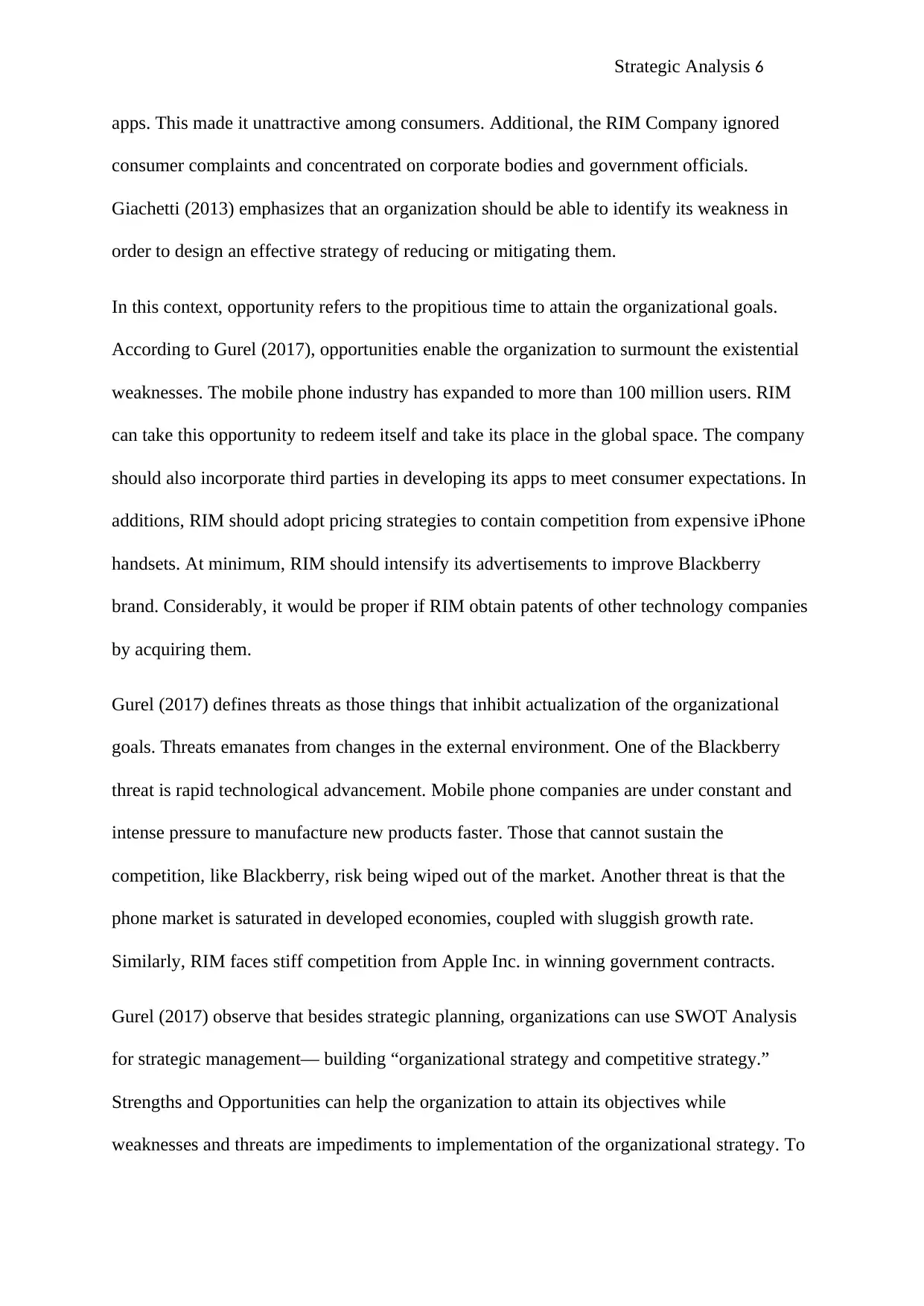
Strategic Analysis 6
apps. This made it unattractive among consumers. Additional, the RIM Company ignored
consumer complaints and concentrated on corporate bodies and government officials.
Giachetti (2013) emphasizes that an organization should be able to identify its weakness in
order to design an effective strategy of reducing or mitigating them.
In this context, opportunity refers to the propitious time to attain the organizational goals.
According to Gurel (2017), opportunities enable the organization to surmount the existential
weaknesses. The mobile phone industry has expanded to more than 100 million users. RIM
can take this opportunity to redeem itself and take its place in the global space. The company
should also incorporate third parties in developing its apps to meet consumer expectations. In
additions, RIM should adopt pricing strategies to contain competition from expensive iPhone
handsets. At minimum, RIM should intensify its advertisements to improve Blackberry
brand. Considerably, it would be proper if RIM obtain patents of other technology companies
by acquiring them.
Gurel (2017) defines threats as those things that inhibit actualization of the organizational
goals. Threats emanates from changes in the external environment. One of the Blackberry
threat is rapid technological advancement. Mobile phone companies are under constant and
intense pressure to manufacture new products faster. Those that cannot sustain the
competition, like Blackberry, risk being wiped out of the market. Another threat is that the
phone market is saturated in developed economies, coupled with sluggish growth rate.
Similarly, RIM faces stiff competition from Apple Inc. in winning government contracts.
Gurel (2017) observe that besides strategic planning, organizations can use SWOT Analysis
for strategic management— building “organizational strategy and competitive strategy.”
Strengths and Opportunities can help the organization to attain its objectives while
weaknesses and threats are impediments to implementation of the organizational strategy. To
apps. This made it unattractive among consumers. Additional, the RIM Company ignored
consumer complaints and concentrated on corporate bodies and government officials.
Giachetti (2013) emphasizes that an organization should be able to identify its weakness in
order to design an effective strategy of reducing or mitigating them.
In this context, opportunity refers to the propitious time to attain the organizational goals.
According to Gurel (2017), opportunities enable the organization to surmount the existential
weaknesses. The mobile phone industry has expanded to more than 100 million users. RIM
can take this opportunity to redeem itself and take its place in the global space. The company
should also incorporate third parties in developing its apps to meet consumer expectations. In
additions, RIM should adopt pricing strategies to contain competition from expensive iPhone
handsets. At minimum, RIM should intensify its advertisements to improve Blackberry
brand. Considerably, it would be proper if RIM obtain patents of other technology companies
by acquiring them.
Gurel (2017) defines threats as those things that inhibit actualization of the organizational
goals. Threats emanates from changes in the external environment. One of the Blackberry
threat is rapid technological advancement. Mobile phone companies are under constant and
intense pressure to manufacture new products faster. Those that cannot sustain the
competition, like Blackberry, risk being wiped out of the market. Another threat is that the
phone market is saturated in developed economies, coupled with sluggish growth rate.
Similarly, RIM faces stiff competition from Apple Inc. in winning government contracts.
Gurel (2017) observe that besides strategic planning, organizations can use SWOT Analysis
for strategic management— building “organizational strategy and competitive strategy.”
Strengths and Opportunities can help the organization to attain its objectives while
weaknesses and threats are impediments to implementation of the organizational strategy. To
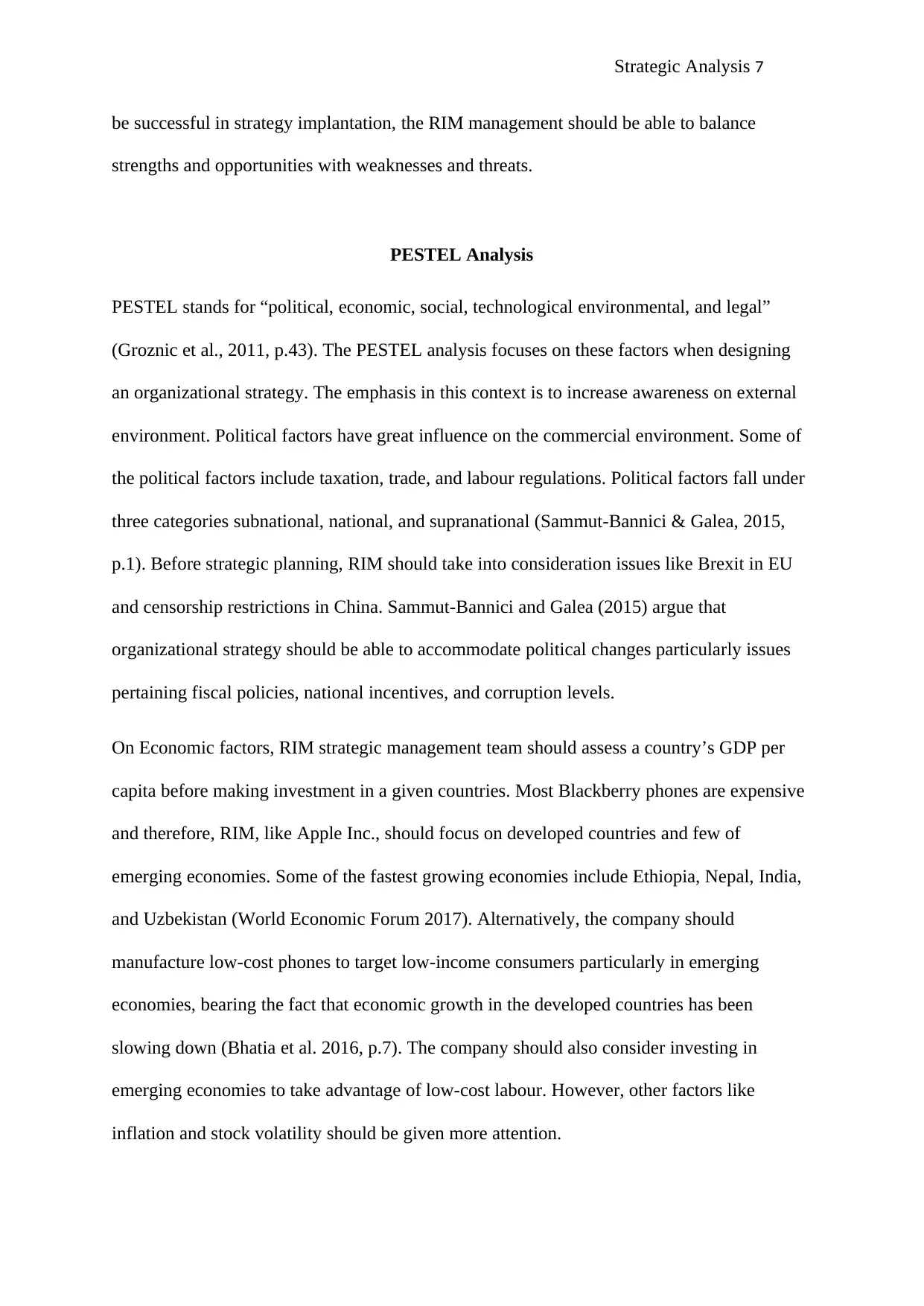
Strategic Analysis 7
be successful in strategy implantation, the RIM management should be able to balance
strengths and opportunities with weaknesses and threats.
PESTEL Analysis
PESTEL stands for “political, economic, social, technological environmental, and legal”
(Groznic et al., 2011, p.43). The PESTEL analysis focuses on these factors when designing
an organizational strategy. The emphasis in this context is to increase awareness on external
environment. Political factors have great influence on the commercial environment. Some of
the political factors include taxation, trade, and labour regulations. Political factors fall under
three categories subnational, national, and supranational (Sammut-Bannici & Galea, 2015,
p.1). Before strategic planning, RIM should take into consideration issues like Brexit in EU
and censorship restrictions in China. Sammut-Bannici and Galea (2015) argue that
organizational strategy should be able to accommodate political changes particularly issues
pertaining fiscal policies, national incentives, and corruption levels.
On Economic factors, RIM strategic management team should assess a country’s GDP per
capita before making investment in a given countries. Most Blackberry phones are expensive
and therefore, RIM, like Apple Inc., should focus on developed countries and few of
emerging economies. Some of the fastest growing economies include Ethiopia, Nepal, India,
and Uzbekistan (World Economic Forum 2017). Alternatively, the company should
manufacture low-cost phones to target low-income consumers particularly in emerging
economies, bearing the fact that economic growth in the developed countries has been
slowing down (Bhatia et al. 2016, p.7). The company should also consider investing in
emerging economies to take advantage of low-cost labour. However, other factors like
inflation and stock volatility should be given more attention.
be successful in strategy implantation, the RIM management should be able to balance
strengths and opportunities with weaknesses and threats.
PESTEL Analysis
PESTEL stands for “political, economic, social, technological environmental, and legal”
(Groznic et al., 2011, p.43). The PESTEL analysis focuses on these factors when designing
an organizational strategy. The emphasis in this context is to increase awareness on external
environment. Political factors have great influence on the commercial environment. Some of
the political factors include taxation, trade, and labour regulations. Political factors fall under
three categories subnational, national, and supranational (Sammut-Bannici & Galea, 2015,
p.1). Before strategic planning, RIM should take into consideration issues like Brexit in EU
and censorship restrictions in China. Sammut-Bannici and Galea (2015) argue that
organizational strategy should be able to accommodate political changes particularly issues
pertaining fiscal policies, national incentives, and corruption levels.
On Economic factors, RIM strategic management team should assess a country’s GDP per
capita before making investment in a given countries. Most Blackberry phones are expensive
and therefore, RIM, like Apple Inc., should focus on developed countries and few of
emerging economies. Some of the fastest growing economies include Ethiopia, Nepal, India,
and Uzbekistan (World Economic Forum 2017). Alternatively, the company should
manufacture low-cost phones to target low-income consumers particularly in emerging
economies, bearing the fact that economic growth in the developed countries has been
slowing down (Bhatia et al. 2016, p.7). The company should also consider investing in
emerging economies to take advantage of low-cost labour. However, other factors like
inflation and stock volatility should be given more attention.
Paraphrase This Document
Need a fresh take? Get an instant paraphrase of this document with our AI Paraphraser
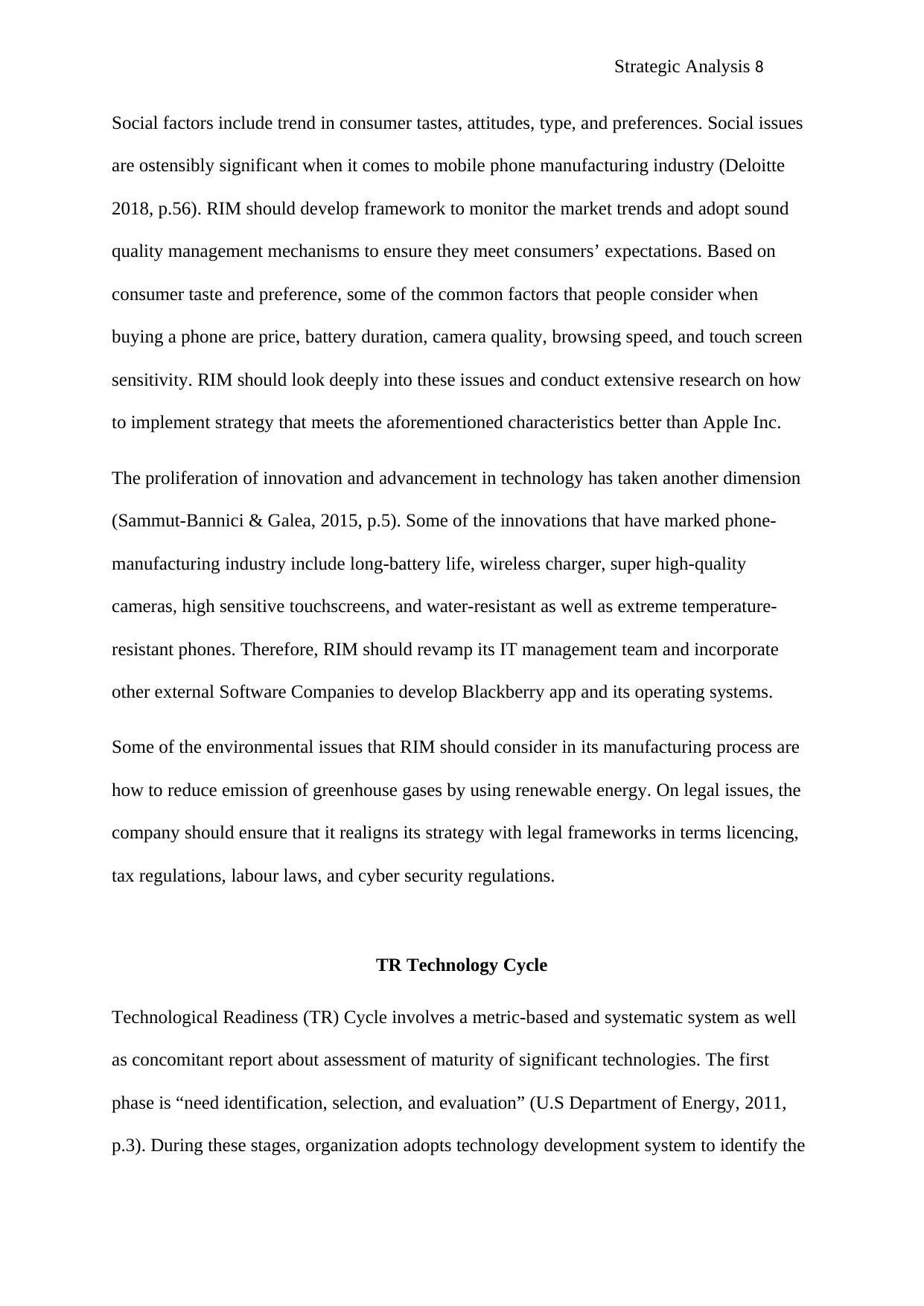
Strategic Analysis 8
Social factors include trend in consumer tastes, attitudes, type, and preferences. Social issues
are ostensibly significant when it comes to mobile phone manufacturing industry (Deloitte
2018, p.56). RIM should develop framework to monitor the market trends and adopt sound
quality management mechanisms to ensure they meet consumers’ expectations. Based on
consumer taste and preference, some of the common factors that people consider when
buying a phone are price, battery duration, camera quality, browsing speed, and touch screen
sensitivity. RIM should look deeply into these issues and conduct extensive research on how
to implement strategy that meets the aforementioned characteristics better than Apple Inc.
The proliferation of innovation and advancement in technology has taken another dimension
(Sammut-Bannici & Galea, 2015, p.5). Some of the innovations that have marked phone-
manufacturing industry include long-battery life, wireless charger, super high-quality
cameras, high sensitive touchscreens, and water-resistant as well as extreme temperature-
resistant phones. Therefore, RIM should revamp its IT management team and incorporate
other external Software Companies to develop Blackberry app and its operating systems.
Some of the environmental issues that RIM should consider in its manufacturing process are
how to reduce emission of greenhouse gases by using renewable energy. On legal issues, the
company should ensure that it realigns its strategy with legal frameworks in terms licencing,
tax regulations, labour laws, and cyber security regulations.
TR Technology Cycle
Technological Readiness (TR) Cycle involves a metric-based and systematic system as well
as concomitant report about assessment of maturity of significant technologies. The first
phase is “need identification, selection, and evaluation” (U.S Department of Energy, 2011,
p.3). During these stages, organization adopts technology development system to identify the
Social factors include trend in consumer tastes, attitudes, type, and preferences. Social issues
are ostensibly significant when it comes to mobile phone manufacturing industry (Deloitte
2018, p.56). RIM should develop framework to monitor the market trends and adopt sound
quality management mechanisms to ensure they meet consumers’ expectations. Based on
consumer taste and preference, some of the common factors that people consider when
buying a phone are price, battery duration, camera quality, browsing speed, and touch screen
sensitivity. RIM should look deeply into these issues and conduct extensive research on how
to implement strategy that meets the aforementioned characteristics better than Apple Inc.
The proliferation of innovation and advancement in technology has taken another dimension
(Sammut-Bannici & Galea, 2015, p.5). Some of the innovations that have marked phone-
manufacturing industry include long-battery life, wireless charger, super high-quality
cameras, high sensitive touchscreens, and water-resistant as well as extreme temperature-
resistant phones. Therefore, RIM should revamp its IT management team and incorporate
other external Software Companies to develop Blackberry app and its operating systems.
Some of the environmental issues that RIM should consider in its manufacturing process are
how to reduce emission of greenhouse gases by using renewable energy. On legal issues, the
company should ensure that it realigns its strategy with legal frameworks in terms licencing,
tax regulations, labour laws, and cyber security regulations.
TR Technology Cycle
Technological Readiness (TR) Cycle involves a metric-based and systematic system as well
as concomitant report about assessment of maturity of significant technologies. The first
phase is “need identification, selection, and evaluation” (U.S Department of Energy, 2011,
p.3). During these stages, organization adopts technology development system to identify the
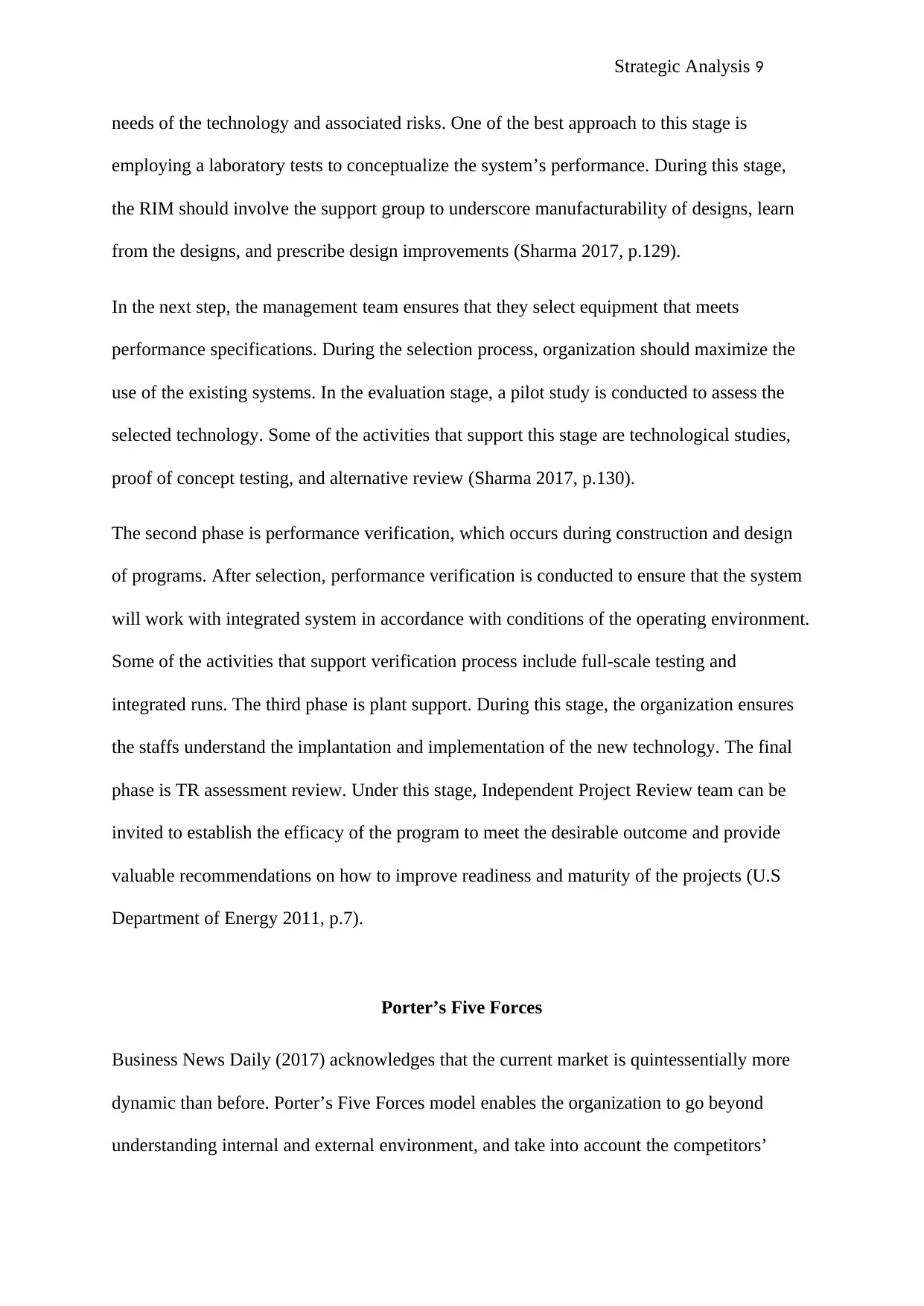
Strategic Analysis 9
needs of the technology and associated risks. One of the best approach to this stage is
employing a laboratory tests to conceptualize the system’s performance. During this stage,
the RIM should involve the support group to underscore manufacturability of designs, learn
from the designs, and prescribe design improvements (Sharma 2017, p.129).
In the next step, the management team ensures that they select equipment that meets
performance specifications. During the selection process, organization should maximize the
use of the existing systems. In the evaluation stage, a pilot study is conducted to assess the
selected technology. Some of the activities that support this stage are technological studies,
proof of concept testing, and alternative review (Sharma 2017, p.130).
The second phase is performance verification, which occurs during construction and design
of programs. After selection, performance verification is conducted to ensure that the system
will work with integrated system in accordance with conditions of the operating environment.
Some of the activities that support verification process include full-scale testing and
integrated runs. The third phase is plant support. During this stage, the organization ensures
the staffs understand the implantation and implementation of the new technology. The final
phase is TR assessment review. Under this stage, Independent Project Review team can be
invited to establish the efficacy of the program to meet the desirable outcome and provide
valuable recommendations on how to improve readiness and maturity of the projects (U.S
Department of Energy 2011, p.7).
Porter’s Five Forces
Business News Daily (2017) acknowledges that the current market is quintessentially more
dynamic than before. Porter’s Five Forces model enables the organization to go beyond
understanding internal and external environment, and take into account the competitors’
needs of the technology and associated risks. One of the best approach to this stage is
employing a laboratory tests to conceptualize the system’s performance. During this stage,
the RIM should involve the support group to underscore manufacturability of designs, learn
from the designs, and prescribe design improvements (Sharma 2017, p.129).
In the next step, the management team ensures that they select equipment that meets
performance specifications. During the selection process, organization should maximize the
use of the existing systems. In the evaluation stage, a pilot study is conducted to assess the
selected technology. Some of the activities that support this stage are technological studies,
proof of concept testing, and alternative review (Sharma 2017, p.130).
The second phase is performance verification, which occurs during construction and design
of programs. After selection, performance verification is conducted to ensure that the system
will work with integrated system in accordance with conditions of the operating environment.
Some of the activities that support verification process include full-scale testing and
integrated runs. The third phase is plant support. During this stage, the organization ensures
the staffs understand the implantation and implementation of the new technology. The final
phase is TR assessment review. Under this stage, Independent Project Review team can be
invited to establish the efficacy of the program to meet the desirable outcome and provide
valuable recommendations on how to improve readiness and maturity of the projects (U.S
Department of Energy 2011, p.7).
Porter’s Five Forces
Business News Daily (2017) acknowledges that the current market is quintessentially more
dynamic than before. Porter’s Five Forces model enables the organization to go beyond
understanding internal and external environment, and take into account the competitors’
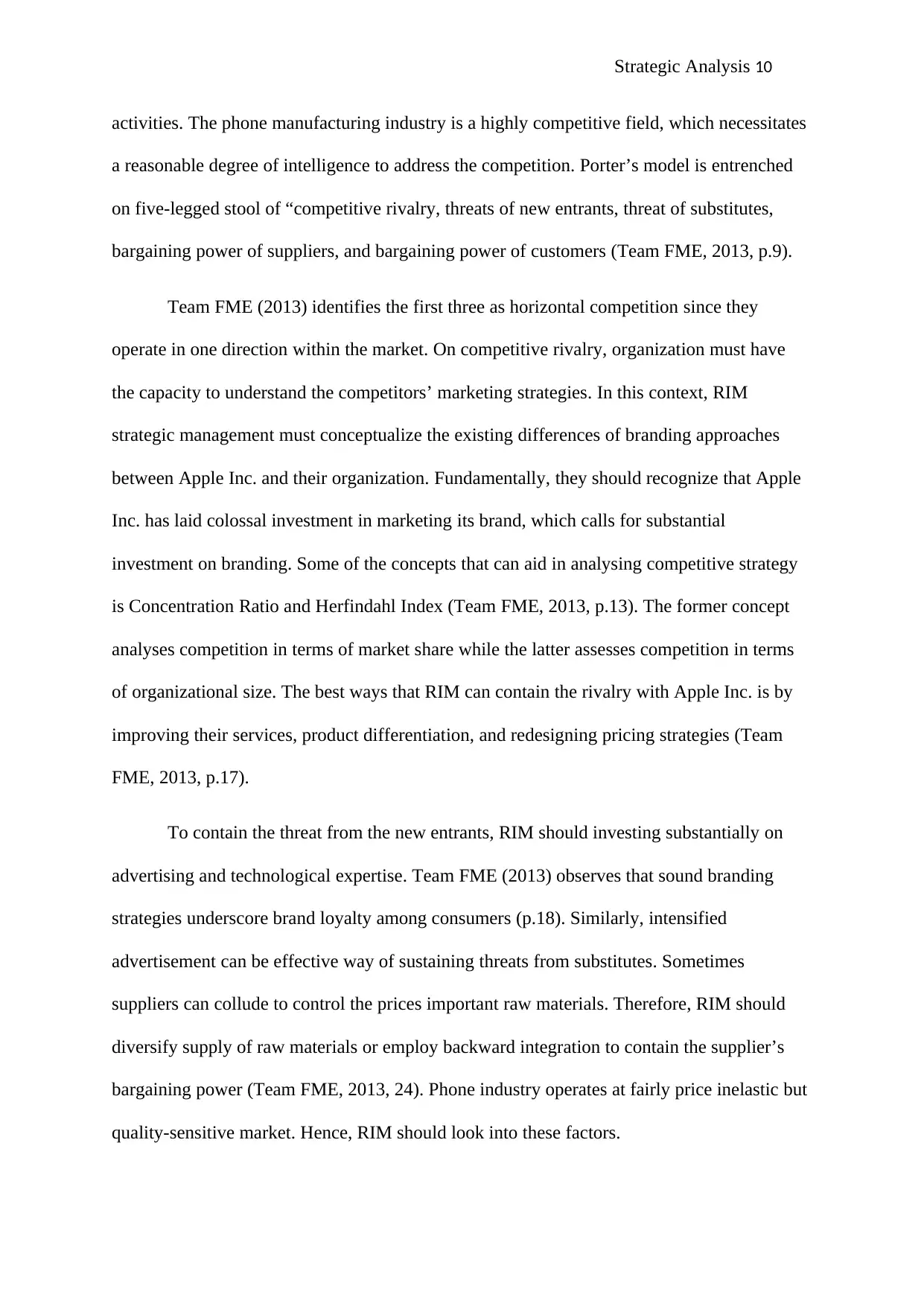
Strategic Analysis 10
activities. The phone manufacturing industry is a highly competitive field, which necessitates
a reasonable degree of intelligence to address the competition. Porter’s model is entrenched
on five-legged stool of “competitive rivalry, threats of new entrants, threat of substitutes,
bargaining power of suppliers, and bargaining power of customers (Team FME, 2013, p.9).
Team FME (2013) identifies the first three as horizontal competition since they
operate in one direction within the market. On competitive rivalry, organization must have
the capacity to understand the competitors’ marketing strategies. In this context, RIM
strategic management must conceptualize the existing differences of branding approaches
between Apple Inc. and their organization. Fundamentally, they should recognize that Apple
Inc. has laid colossal investment in marketing its brand, which calls for substantial
investment on branding. Some of the concepts that can aid in analysing competitive strategy
is Concentration Ratio and Herfindahl Index (Team FME, 2013, p.13). The former concept
analyses competition in terms of market share while the latter assesses competition in terms
of organizational size. The best ways that RIM can contain the rivalry with Apple Inc. is by
improving their services, product differentiation, and redesigning pricing strategies (Team
FME, 2013, p.17).
To contain the threat from the new entrants, RIM should investing substantially on
advertising and technological expertise. Team FME (2013) observes that sound branding
strategies underscore brand loyalty among consumers (p.18). Similarly, intensified
advertisement can be effective way of sustaining threats from substitutes. Sometimes
suppliers can collude to control the prices important raw materials. Therefore, RIM should
diversify supply of raw materials or employ backward integration to contain the supplier’s
bargaining power (Team FME, 2013, 24). Phone industry operates at fairly price inelastic but
quality-sensitive market. Hence, RIM should look into these factors.
activities. The phone manufacturing industry is a highly competitive field, which necessitates
a reasonable degree of intelligence to address the competition. Porter’s model is entrenched
on five-legged stool of “competitive rivalry, threats of new entrants, threat of substitutes,
bargaining power of suppliers, and bargaining power of customers (Team FME, 2013, p.9).
Team FME (2013) identifies the first three as horizontal competition since they
operate in one direction within the market. On competitive rivalry, organization must have
the capacity to understand the competitors’ marketing strategies. In this context, RIM
strategic management must conceptualize the existing differences of branding approaches
between Apple Inc. and their organization. Fundamentally, they should recognize that Apple
Inc. has laid colossal investment in marketing its brand, which calls for substantial
investment on branding. Some of the concepts that can aid in analysing competitive strategy
is Concentration Ratio and Herfindahl Index (Team FME, 2013, p.13). The former concept
analyses competition in terms of market share while the latter assesses competition in terms
of organizational size. The best ways that RIM can contain the rivalry with Apple Inc. is by
improving their services, product differentiation, and redesigning pricing strategies (Team
FME, 2013, p.17).
To contain the threat from the new entrants, RIM should investing substantially on
advertising and technological expertise. Team FME (2013) observes that sound branding
strategies underscore brand loyalty among consumers (p.18). Similarly, intensified
advertisement can be effective way of sustaining threats from substitutes. Sometimes
suppliers can collude to control the prices important raw materials. Therefore, RIM should
diversify supply of raw materials or employ backward integration to contain the supplier’s
bargaining power (Team FME, 2013, 24). Phone industry operates at fairly price inelastic but
quality-sensitive market. Hence, RIM should look into these factors.
Secure Best Marks with AI Grader
Need help grading? Try our AI Grader for instant feedback on your assignments.
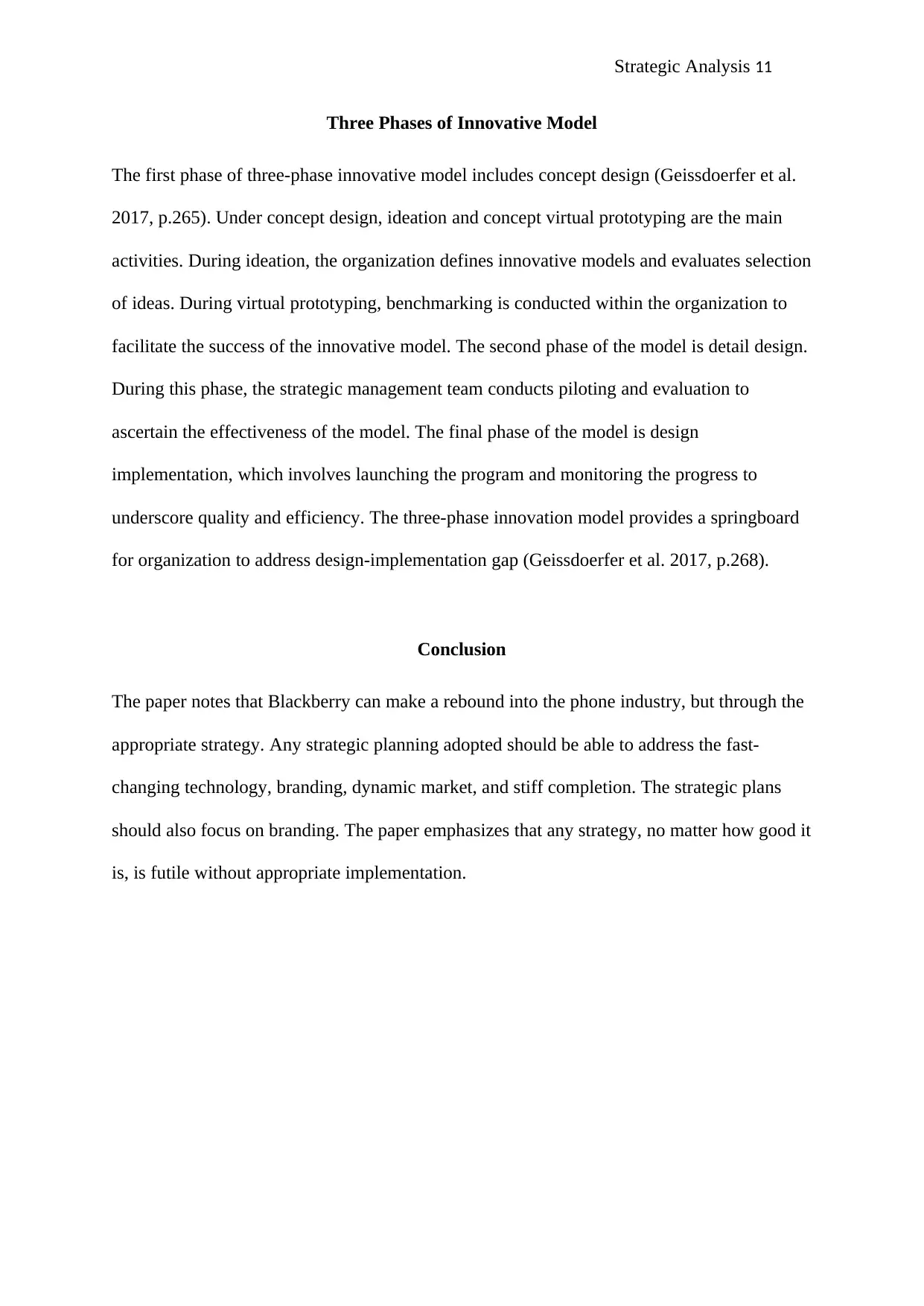
Strategic Analysis 11
Three Phases of Innovative Model
The first phase of three-phase innovative model includes concept design (Geissdoerfer et al.
2017, p.265). Under concept design, ideation and concept virtual prototyping are the main
activities. During ideation, the organization defines innovative models and evaluates selection
of ideas. During virtual prototyping, benchmarking is conducted within the organization to
facilitate the success of the innovative model. The second phase of the model is detail design.
During this phase, the strategic management team conducts piloting and evaluation to
ascertain the effectiveness of the model. The final phase of the model is design
implementation, which involves launching the program and monitoring the progress to
underscore quality and efficiency. The three-phase innovation model provides a springboard
for organization to address design-implementation gap (Geissdoerfer et al. 2017, p.268).
Conclusion
The paper notes that Blackberry can make a rebound into the phone industry, but through the
appropriate strategy. Any strategic planning adopted should be able to address the fast-
changing technology, branding, dynamic market, and stiff completion. The strategic plans
should also focus on branding. The paper emphasizes that any strategy, no matter how good it
is, is futile without appropriate implementation.
Three Phases of Innovative Model
The first phase of three-phase innovative model includes concept design (Geissdoerfer et al.
2017, p.265). Under concept design, ideation and concept virtual prototyping are the main
activities. During ideation, the organization defines innovative models and evaluates selection
of ideas. During virtual prototyping, benchmarking is conducted within the organization to
facilitate the success of the innovative model. The second phase of the model is detail design.
During this phase, the strategic management team conducts piloting and evaluation to
ascertain the effectiveness of the model. The final phase of the model is design
implementation, which involves launching the program and monitoring the progress to
underscore quality and efficiency. The three-phase innovation model provides a springboard
for organization to address design-implementation gap (Geissdoerfer et al. 2017, p.268).
Conclusion
The paper notes that Blackberry can make a rebound into the phone industry, but through the
appropriate strategy. Any strategic planning adopted should be able to address the fast-
changing technology, branding, dynamic market, and stiff completion. The strategic plans
should also focus on branding. The paper emphasizes that any strategy, no matter how good it
is, is futile without appropriate implementation.

Strategic Analysis 12

Strategic Analysis 13
List of References
The American Genius. (2018, January 8). How BlackBerry Will Survive If they No Longer
Make Phones - The American Genius. (Online). Available at
https://theamericangenius.com/business-news/blackberry-survival/
Bhatia, M. P., Kumar, A., & Beniwal, R. 2016. SWOT Analysis of Ontology Driven
Software Engineering. Indian Journal of Science and Technology, Vol 9, no38.
doi:10.17485/ijst/2016/v9i38/102970
Business News Daily. (2017, June 26). Porter's Five Forces: Analyzing the Competition.
Online, Available at https://www.businessnewsdaily.com/5446-porters-five-forces.html
Chu, Y. 2017. SWOT Analysis and Countermeasures of India market environment for
Domestic Mobile Phone. Proceedings of the 2017 International Conference on Education,
Culture and Social Development (ICECSD 2017), Vol 80. doi:10.2991/icecsd-17.2017.4
Deloitte. J. 2018. Technology, Media and Telecommunications Predictions. Online,
Available at https://www2.deloitte.com/content/dam/Deloitte/global/Images/infographics/
technologymediatelecommunications/gx-deloitte-tmt-2018-predictions-full-report.pdf
Geissdoerfer, M., Paulo, S., & Steve, E. 2017. The Cambridge Business Model Innovation
Process. Procedia Manufacturing, Vol 8, pp262-269. doi:10.1016/j.promfg.2017.02.033
Giachetti, C. 2013. New Technology Imitation. Competitive Dynamics in the Mobile Phone
Industry, pp93-114. doi:10.1057/9781137374127.0011
The Globe and Mail. (2018, April 7). How BlackBerry blew it: The inside story. Online,
Available at: https://www.theglobeandmail.com/report-on-business/the-inside-story-of-why-
blackberry-is-failing/article14563602/
List of References
The American Genius. (2018, January 8). How BlackBerry Will Survive If they No Longer
Make Phones - The American Genius. (Online). Available at
https://theamericangenius.com/business-news/blackberry-survival/
Bhatia, M. P., Kumar, A., & Beniwal, R. 2016. SWOT Analysis of Ontology Driven
Software Engineering. Indian Journal of Science and Technology, Vol 9, no38.
doi:10.17485/ijst/2016/v9i38/102970
Business News Daily. (2017, June 26). Porter's Five Forces: Analyzing the Competition.
Online, Available at https://www.businessnewsdaily.com/5446-porters-five-forces.html
Chu, Y. 2017. SWOT Analysis and Countermeasures of India market environment for
Domestic Mobile Phone. Proceedings of the 2017 International Conference on Education,
Culture and Social Development (ICECSD 2017), Vol 80. doi:10.2991/icecsd-17.2017.4
Deloitte. J. 2018. Technology, Media and Telecommunications Predictions. Online,
Available at https://www2.deloitte.com/content/dam/Deloitte/global/Images/infographics/
technologymediatelecommunications/gx-deloitte-tmt-2018-predictions-full-report.pdf
Geissdoerfer, M., Paulo, S., & Steve, E. 2017. The Cambridge Business Model Innovation
Process. Procedia Manufacturing, Vol 8, pp262-269. doi:10.1016/j.promfg.2017.02.033
Giachetti, C. 2013. New Technology Imitation. Competitive Dynamics in the Mobile Phone
Industry, pp93-114. doi:10.1057/9781137374127.0011
The Globe and Mail. (2018, April 7). How BlackBerry blew it: The inside story. Online,
Available at: https://www.theglobeandmail.com/report-on-business/the-inside-story-of-why-
blackberry-is-failing/article14563602/
Paraphrase This Document
Need a fresh take? Get an instant paraphrase of this document with our AI Paraphraser
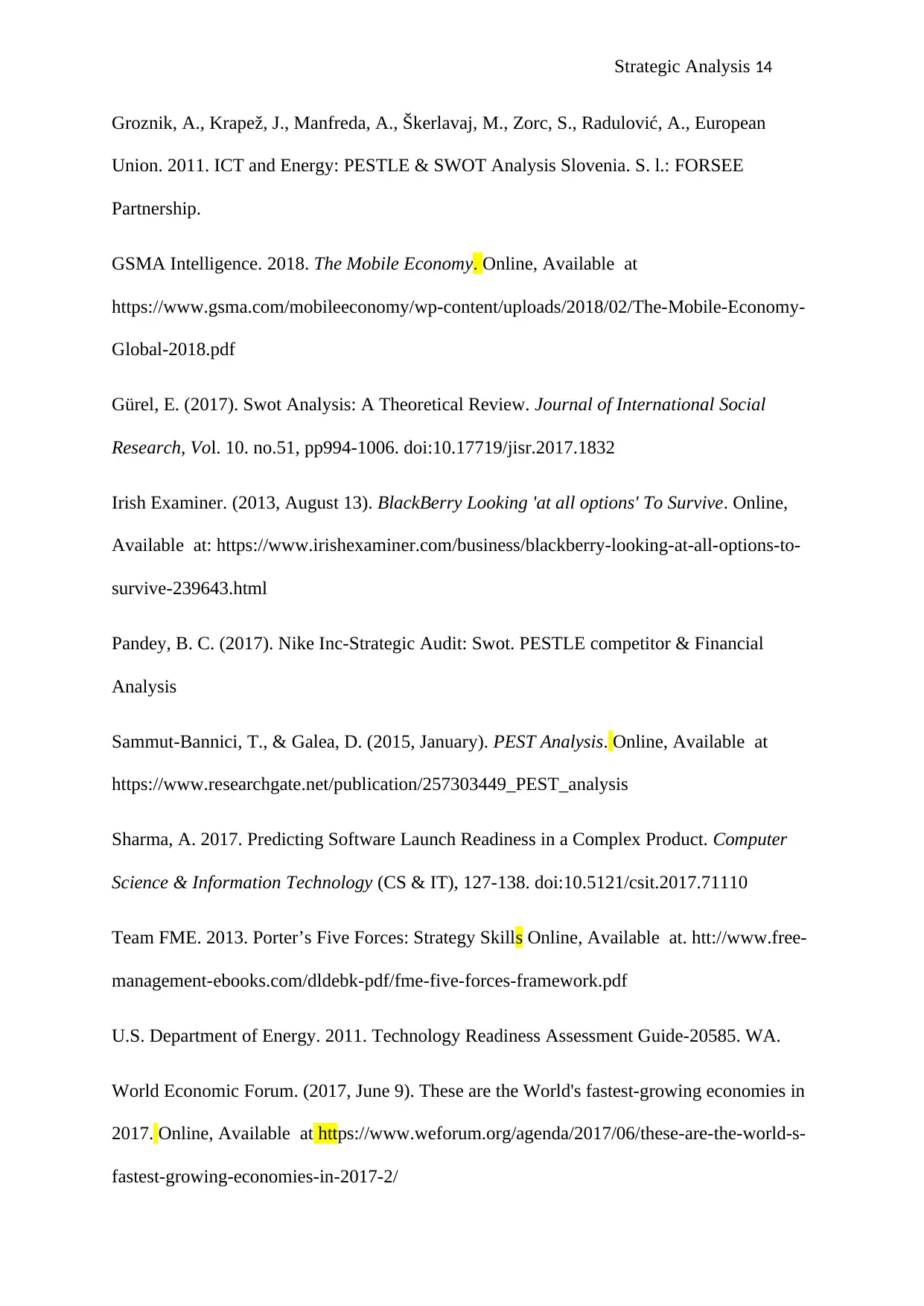
Strategic Analysis 14
Groznik, A., Krapež, J., Manfreda, A., Š kerlavaj, M., Zorc, S., Radulović, A., European
Union. 2011. ICT and Energy: PESTLE & SWOT Analysis Slovenia. S. l.: FORSEE
Partnership.
GSMA Intelligence. 2018. The Mobile Economy. Online, Available at
https://www.gsma.com/mobileeconomy/wp-content/uploads/2018/02/The-Mobile-Economy-
Global-2018.pdf
Gürel, E. (2017). Swot Analysis: A Theoretical Review. Journal of International Social
Research, Vol. 10. no.51, pp994-1006. doi:10.17719/jisr.2017.1832
Irish Examiner. (2013, August 13). BlackBerry Looking 'at all options' To Survive. Online,
Available at: https://www.irishexaminer.com/business/blackberry-looking-at-all-options-to-
survive-239643.html
Pandey, B. C. (2017). Nike Inc-Strategic Audit: Swot. PESTLE competitor & Financial
Analysis
Sammut-Bannici, T., & Galea, D. (2015, January). PEST Analysis. Online, Available at
https://www.researchgate.net/publication/257303449_PEST_analysis
Sharma, A. 2017. Predicting Software Launch Readiness in a Complex Product. Computer
Science & Information Technology (CS & IT), 127-138. doi:10.5121/csit.2017.71110
Team FME. 2013. Porter’s Five Forces: Strategy Skills Online, Available at. htt://www.free-
management-ebooks.com/dldebk-pdf/fme-five-forces-framework.pdf
U.S. Department of Energy. 2011. Technology Readiness Assessment Guide-20585. WA.
World Economic Forum. (2017, June 9). These are the World's fastest-growing economies in
2017. Online, Available at https://www.weforum.org/agenda/2017/06/these-are-the-world-s-
fastest-growing-economies-in-2017-2/
Groznik, A., Krapež, J., Manfreda, A., Š kerlavaj, M., Zorc, S., Radulović, A., European
Union. 2011. ICT and Energy: PESTLE & SWOT Analysis Slovenia. S. l.: FORSEE
Partnership.
GSMA Intelligence. 2018. The Mobile Economy. Online, Available at
https://www.gsma.com/mobileeconomy/wp-content/uploads/2018/02/The-Mobile-Economy-
Global-2018.pdf
Gürel, E. (2017). Swot Analysis: A Theoretical Review. Journal of International Social
Research, Vol. 10. no.51, pp994-1006. doi:10.17719/jisr.2017.1832
Irish Examiner. (2013, August 13). BlackBerry Looking 'at all options' To Survive. Online,
Available at: https://www.irishexaminer.com/business/blackberry-looking-at-all-options-to-
survive-239643.html
Pandey, B. C. (2017). Nike Inc-Strategic Audit: Swot. PESTLE competitor & Financial
Analysis
Sammut-Bannici, T., & Galea, D. (2015, January). PEST Analysis. Online, Available at
https://www.researchgate.net/publication/257303449_PEST_analysis
Sharma, A. 2017. Predicting Software Launch Readiness in a Complex Product. Computer
Science & Information Technology (CS & IT), 127-138. doi:10.5121/csit.2017.71110
Team FME. 2013. Porter’s Five Forces: Strategy Skills Online, Available at. htt://www.free-
management-ebooks.com/dldebk-pdf/fme-five-forces-framework.pdf
U.S. Department of Energy. 2011. Technology Readiness Assessment Guide-20585. WA.
World Economic Forum. (2017, June 9). These are the World's fastest-growing economies in
2017. Online, Available at https://www.weforum.org/agenda/2017/06/these-are-the-world-s-
fastest-growing-economies-in-2017-2/

Strategic Analysis 15
1 out of 15
Related Documents
Your All-in-One AI-Powered Toolkit for Academic Success.
+13062052269
info@desklib.com
Available 24*7 on WhatsApp / Email
![[object Object]](/_next/static/media/star-bottom.7253800d.svg)
Unlock your academic potential
© 2024 | Zucol Services PVT LTD | All rights reserved.





